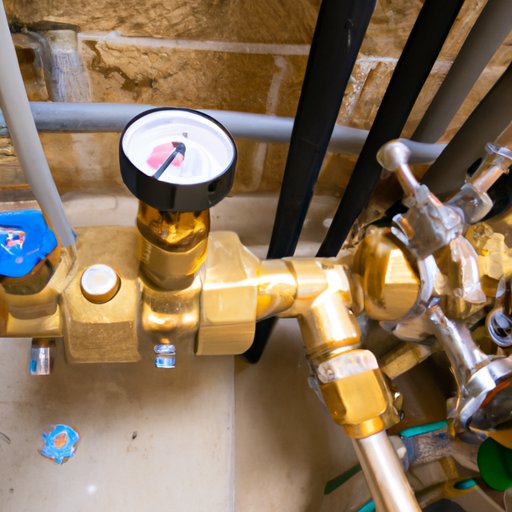
I. Introduction
There’s nothing more frustrating than a weak stream of water while taking a shower or doing the dishes. Low water pressure can be a significant nuisance in any household, and it is a common problem that homeowners face. Fortunately, there are several ways to increase water pressure and improve water flow. In this article, we’ll provide you with a guide on how to increase water pressure in your home.
II. Adjust the Pressure Regulator Valve
The pressure regulator valve controls the pressure of water entering your home. If the valve is not correctly adjusted, it can lead to low water pressure. Before adjusting the valve, make sure to turn off the water supply to your home. The valve is typically located at the main water supply line where it enters your home.
To adjust the valve:
- Use a wrench to loosen the lock nut on top of the valve and turn the adjusting screw clockwise to increase pressure.
- Use a pressure gauge to check the water pressure and ensure that it’s within the recommended range of 45 to 60 pounds per square inch (psi).
- Tighten the lock nut back in place once you’ve achieved the desired pressure.
It’s essential to handle the valve with care and not over-adjust it, as doing so can damage your plumbing system and lead to leaks.
III. Remove Mineral Buildup
Mineral buildup in pipes and fixtures can cause low water pressure. Hard water contains high levels of minerals such as calcium and magnesium that build up in pipes and fixtures over time. To identify mineral buildup:
- Check for a crusty white or reddish-brown buildup around faucets, showerheads, and other plumbing fixtures.
- Notice any unusual odors or taste in the water.
- Inspect the water heater for signs of mineral buildup.
To clean out mineral buildup:
- Unscrew the fixture or remove the showerhead and soak it in vinegar or a commercial descaler for the recommended amount of time.
- Rinse the fixture thoroughly with water and dry it before reinstalling it.
Regular cleaning can prevent future mineral buildup and improve water pressure.
IV. Fix Leaking Pipes
Leaking pipes can cause low water pressure as water gets diverted from the main supply to the leak. Signs of leaking pipes include:
- Damp walls and floors
- Water stains or wet spots
- A sudden increase in water bills
Fixing leaking pipes involves:
- Identifying the source of the leak.
- Turning off the main water supply valve and draining the pipes.
- Replacing the damaged section of the pipe or sealing the leak if it’s minor.
- Restoring water supply and checking for leaks and water pressure.
It’s advisable to call a professional plumber to fix any significant leaks that may affect your entire plumbing system.
V. Upgrade Plumbing Fixtures
Outdated or worn-out plumbing fixtures can also cause low water pressure. Newer fixtures are designed to conserve water without compromising water pressure. Types of modern plumbing fixtures to consider include:
- Low-flow showerheads and faucets
- High-pressure toilets
- Efficient dishwashers and washing machines
Upgrading your plumbing fixtures can not only boost water pressure but also increase energy efficiency and reduce water bills.
VI. Replace Pipes
Old or damaged pipes can cause low water pressure and pose health risks due to contaminants. Indications that it’s time to replace your pipes include:
- Rust-colored water
- Decreased water pressure throughout the house
- Frequent leaks and pipe bursts
Factors to consider when replacing pipes:
- Age and material of existing pipes
- The extent of damage to the pipes
- Cost, including labor and materials
- Local building codes and permits
It’s advisable to consult a plumbing professional to assess your plumbing system and advise on the best course of action.
VII. Install a Pressure Booster Pump
A pressure booster pump is an automatic device that increases water pressure in your pipes. It’s an ideal solution if you live in a low-pressure area or if several fixtures require high water pressure. Installing a pressure booster pump involves:
- Choosing a suitable location for the pump near an electrical outlet and water supply line.
- Attaching the pump to the supply line and installing a pressure tank to store water and maintain constant pressure.
- Wiring the pump to the electrical system and programming it to the desired pressure settings.
- Testing the pump and monitoring it for any leaks or malfunctions.
The benefits of using a pressure booster pump include improved water pressure, reduced water bills, and extended lifespan of plumbing fixtures.
VIII. Conclusion
In conclusion, low water pressure doesn’t have to be a source of frustration in your home. As outlined in this article, adjusting the pressure regulator valve, removing mineral buildup, fixing leaking pipes, upgrading plumbing fixtures, replacing pipes, and installing a pressure booster pump are all potential solutions that can improve water pressure and flow. Choosing the right solution depends on the nature of the problem, the condition of your plumbing system, and your preferences and budget. Take action today and enjoy a more comfortable and efficient water supply in your home.
We hope this guide on how to increase water pressure has been helpful. For more expert advice and plumbing solutions, contact your local plumbing professional.





